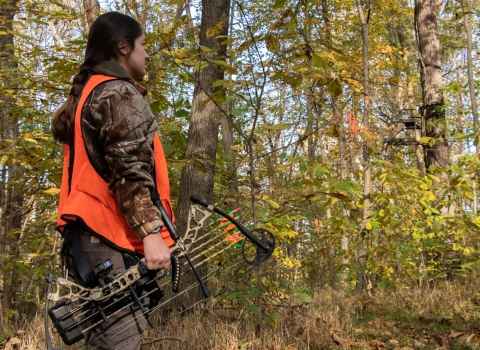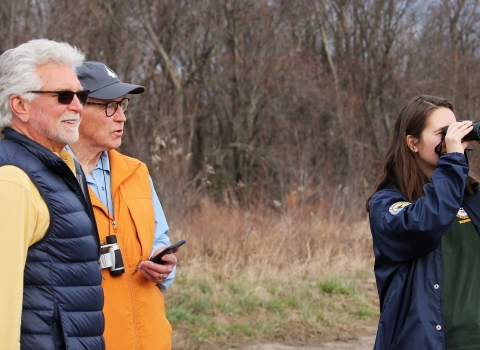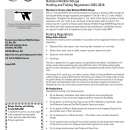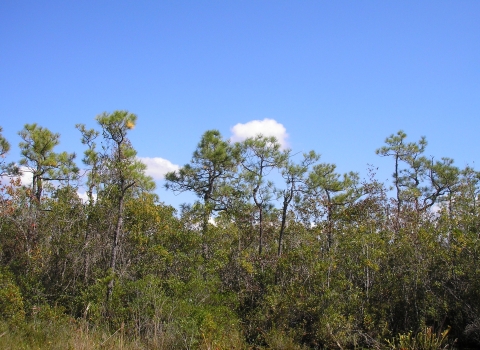


Visit Us
National wildlife refuges offer us all a chance to unplug from the stresses of daily life and reconnect with our natural surroundings. Pocosin Lakes National Wildlife Refuge provides numerous recreation opportunities to visitors every year, whether driving, boating, biking, or hiking. Stop by the Walter B. Jones, Sr. Center for the Sounds in Columbia to explore the interactive displays and take a stroll along the Scuppernong River Boardwalk—sunsets over the Scuppernong are a must-see! Head to the Pungo Unit to see black bear, winter waterfowl, and other wildlife. Pocosin Lakes National Wildlife Refuge offers excellent wildlife photography opportunities, especially in early mornings and late afternoons, when wildlife is most active and lighting can be spectacular. Visitors can enjoy wildlife viewing and photography, birding, hunting, fishing, hiking, and biking.
Things to Do
- Stop by the Walter B. Jones, Sr. Center for the Sounds in Columbia to explore the interactive displays.
- Slow down and immerse yourself in nature with a stroll along the Scuppernong River Boardwalk--look closely for turtles, flowers, and other wildlife!
- Join in on a Red Wolf Program at the Red Wolf Center to learn about the history, biology, and management of red wolves and have a chance of seeing captive red wolves!
- Tour the Pungo Unit for a chance of seeing black bear, wintering waterfowl, and other wildlife. The dawn and dusk winter roosts of thousands of swans and geese are a must-see!
- Learn about endangered red wolves, join a guided waterfowl tour, or explore other topics through interpretive programs and special events!
- Hunting and fishing are allowed on the refuge with restrictions.
Location and Contact Information
What We Do
Wildlife conservation is at the heart of the National Wildlife Refuge System. It drives everything on U.S. Fish and Wildlife Service lands and waters managed within the Refuge System, from the purposes for which a national wildlife refuge national wildlife refuge
A national wildlife refuge is typically a contiguous area of land and water managed by the U.S. Fish and Wildlife Service for the conservation and, where appropriate, restoration of fish, wildlife and plant resources and their habitats for the benefit of present and future generations of Americans.
Learn more about national wildlife refuge is established to the recreational activities offered to the resource management tools used. Using conservation best practices, the Refuge System manages Service lands and waters to help ensure the survival of native wildlife species.
Habitat management at Pocosin Lakes NWR is greatly influenced by fire and water. The refuge’s water management keeps the peat soils moist, protecting them from destructive wildfire and restoring natural biochemical processes in the wetland. Pocosins are a fire-adapted ecosystem. Many plant communities found in pocosin wetlands require fire to persist in healthy conditions. Prescribed fire reduces the likelihood of catastrophic wildfires, releases nutrients back into the soil, removes undesirable vegetation, and stimulates growth of early successional plants that are eaten by a variety of wildlife. In addition, the cooperative farming program on the refuge allows local farmers to farm on refuge lands in exchange for leaving a portion of the crop as high-energy food for waterfowl and other wildlife.
Projects and Research
Audio Described Version
Pocosin Lakes National Wildlife Refuge encompasses approximately 110,106 acres of Washington, Hyde, and Tyrrell Counties in eastern North Carolina. In addition to more than 8,300 acres of managed waterfowl habitat, the refuge also has more than 101,600 acres of pocosin peatlands. Pocosin (a Native American term meaning “swamp on a hill...






